Weaviate v1.30 includes a host of new features and improvements. It introduces API-based database user management, runtime RAG configurations, multi-vector (ColBERT-like) embedding quantization.
It also brings BlockMax WAND and multi-vector embeddings to general availability (GA), indicating their readiness for production use. There are other enhancements, including xAI model integrations and runtime configuration management, and more.
Here are the release ⭐️highlights⭐️!
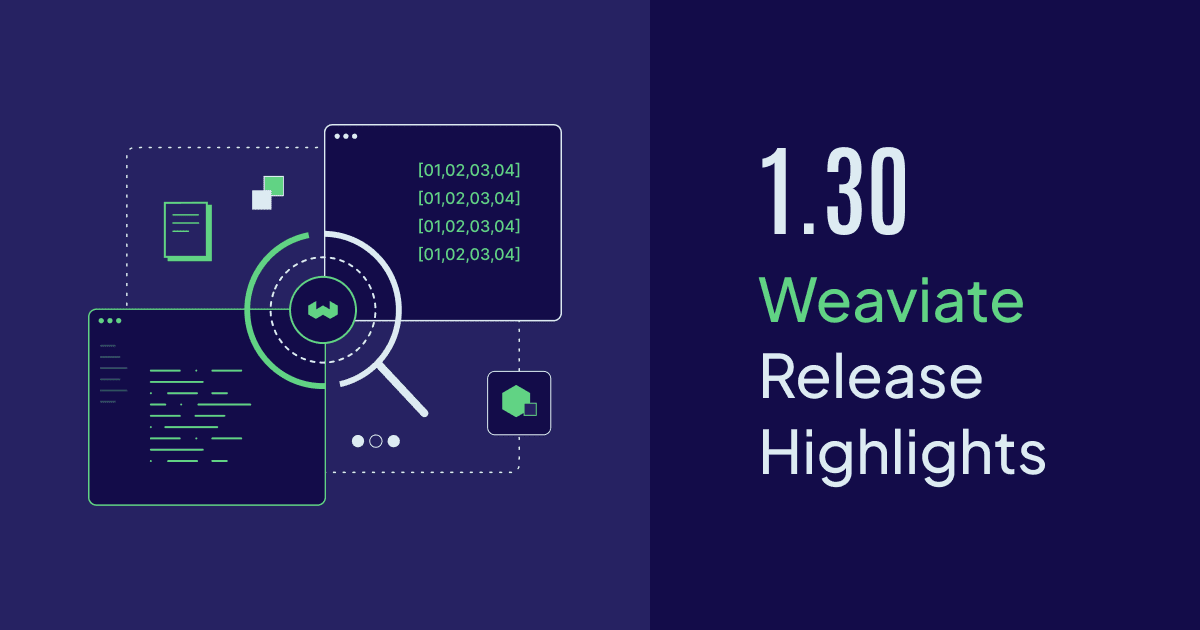
- BlockMax WAND in GA
- Multi-vector embeddings - GA & quantization
- Database user management API
- Generative (RAG) capability improvements
- xAI model integration
- Other enhancements
BlockMax WAND in GA
BlockMax WAND significantly speeds up keyword and hybrid searches in Weaviate. Originally introduced as a technical preview in 1.28, it is now generally available in v1.30. In fact, it is now the default indexing algorithm for all new Weaviate instances from this version onwards.
At a high level, BlockMax WAND is an algorithm that optimizes the scoring of documents in a search index for lexical (keyword) queries. This can be especially useful for large datasets, for example large e-commerce catalogs or a library of complex (legal/medical/domain-specific) documents.
It does this by pre-computing statistics for blocks of documents in the index, allowing it to quickly skip over blocks that are unlikely to contain relevant documents. We have seen up to a 10x speedup in keyword searches due to BlockMax WAND.
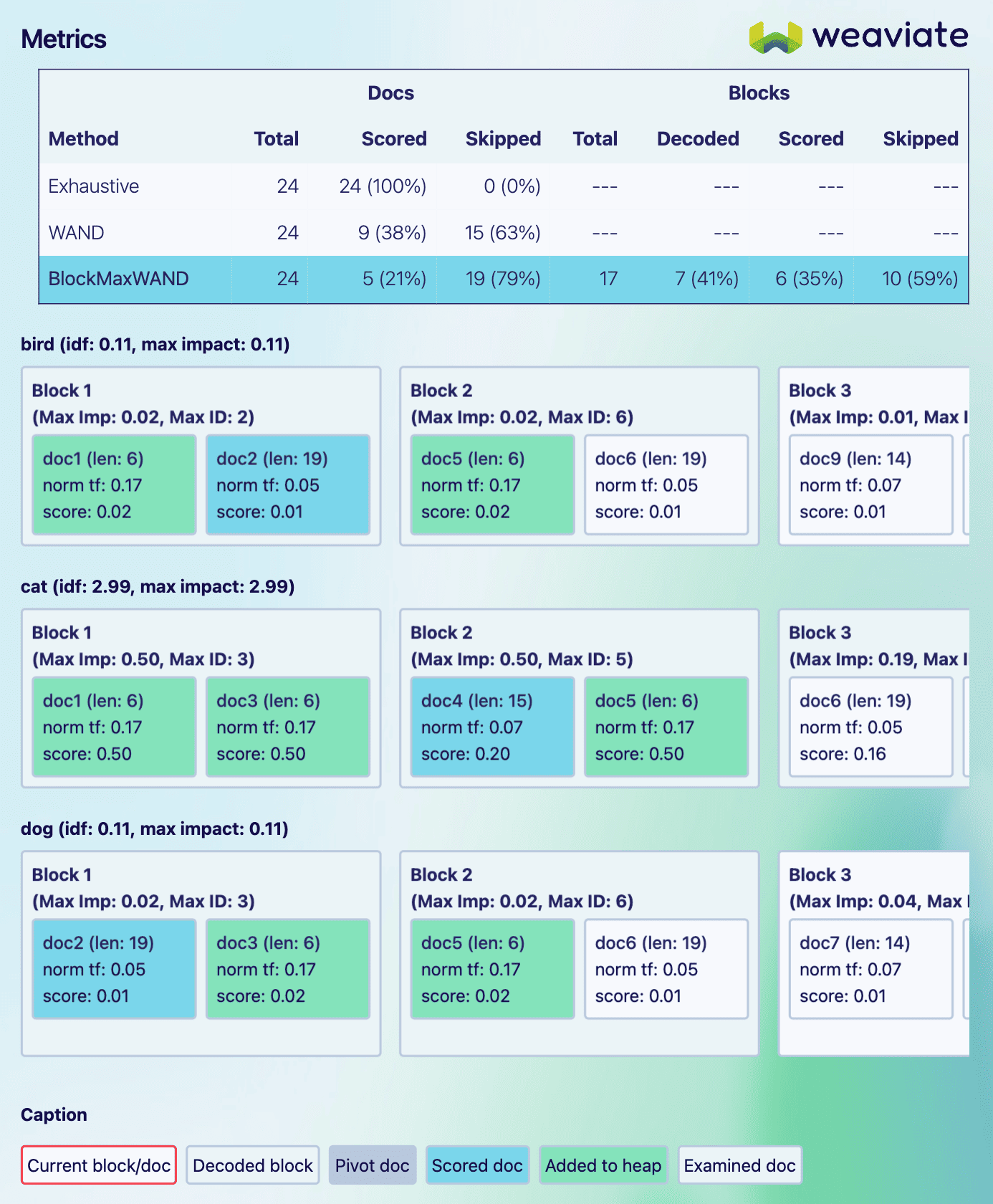
Read the full blog post
Existing instances' data can be migrated to use BlockMax WAND by following this guide. This is a one-time operation, and once completed, the instance will use BlockMax WAND for all future searches.
If you are going to create a new Weaviate instance, you do not need to do anything - BlockMax WAND will be used by default.
Enjoy the speedup! 🚀🚀🚀
Multi-vector embeddings
ColBERT or ColPali-like multi-vector embeddings are now generally available in Weaviate for production use. Here is an illustration showing the difference between single-vector and multi-vector embeddings.
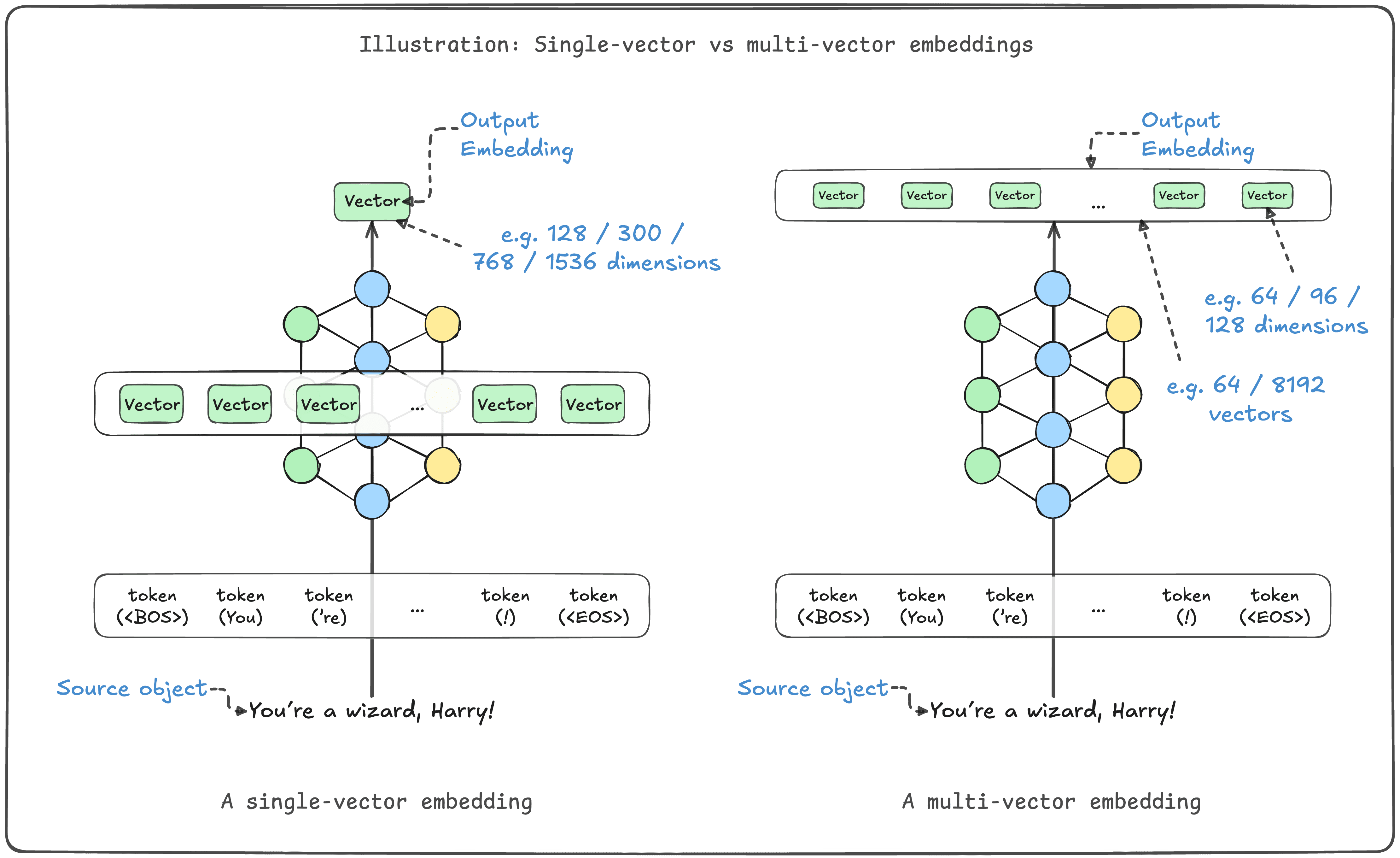
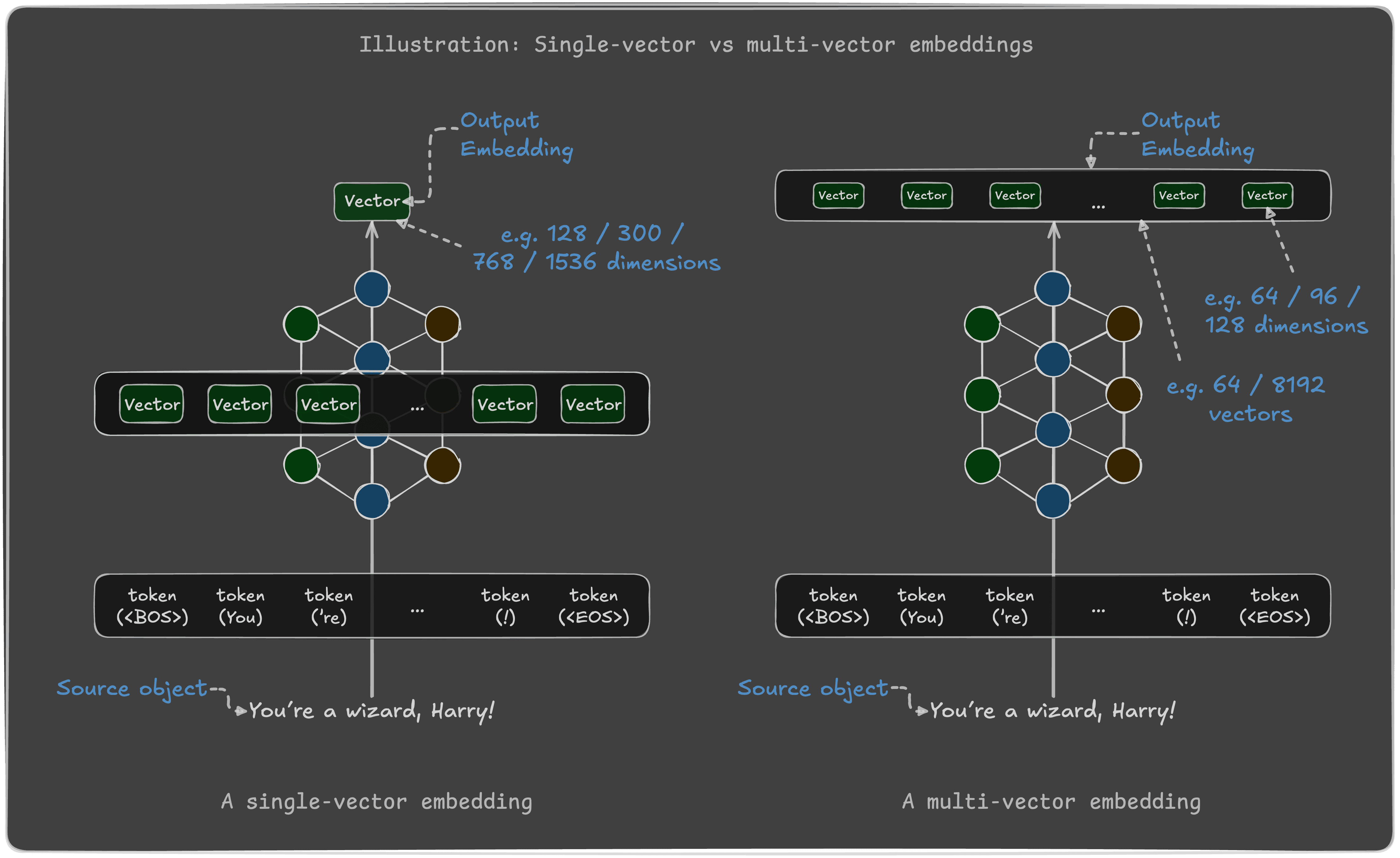
Multi-vector embeddings allow you to store and query multi-vector embeddings such as those from ColBERT, ColPali and ColQwen models. This approach enables more precise searching through "late interaction" - a technique that matches individual parts of texts rather than comparing them as whole units.
This was introduced in v1.29 as a technical preview, and is now generally available in v1.30. This means that the feature is considered stable and ready for production use.
In addition to this, we are very pleased to announce that multi-vector embeddings can now be quantized in Weaviate for reduced memory footprint.
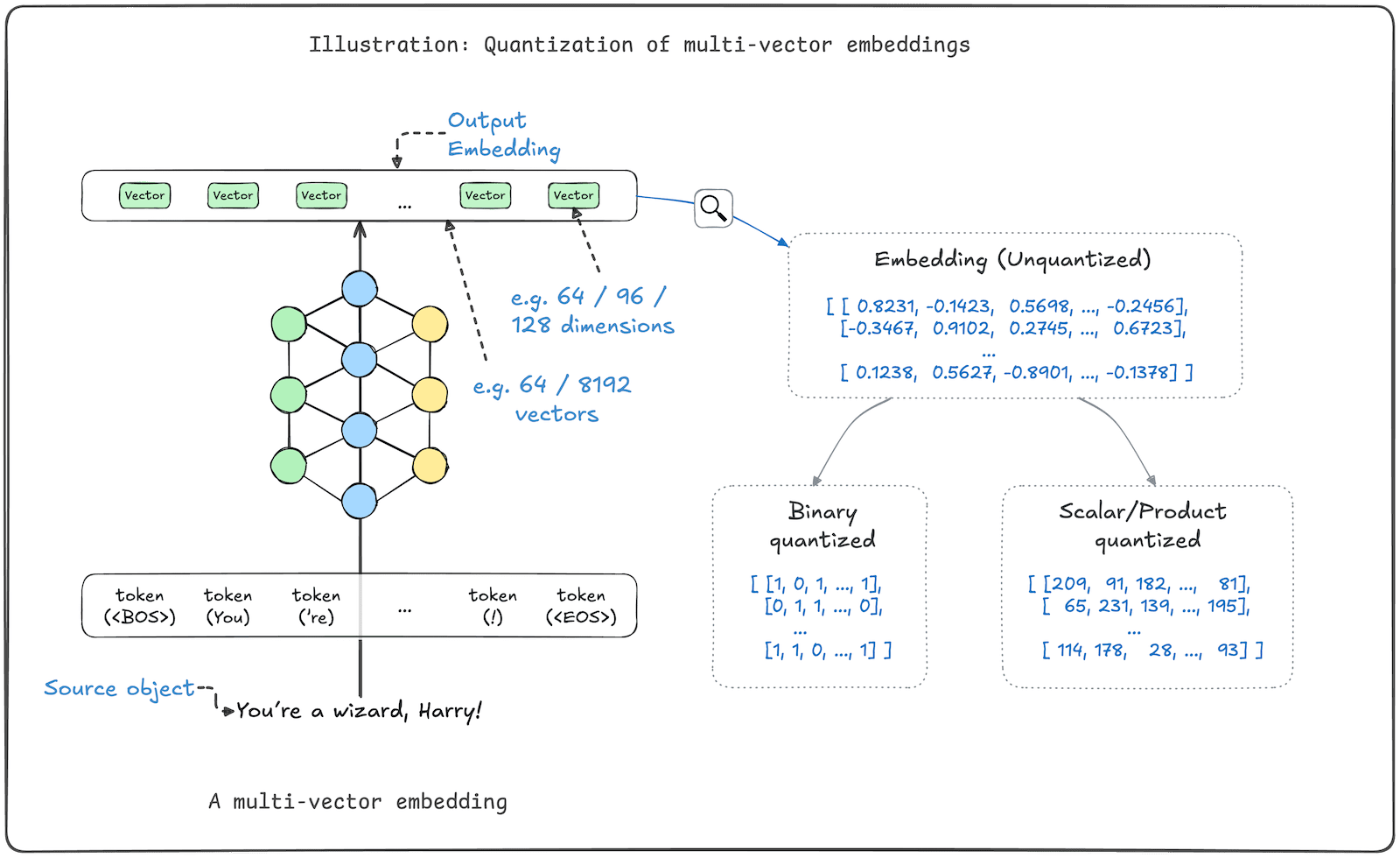
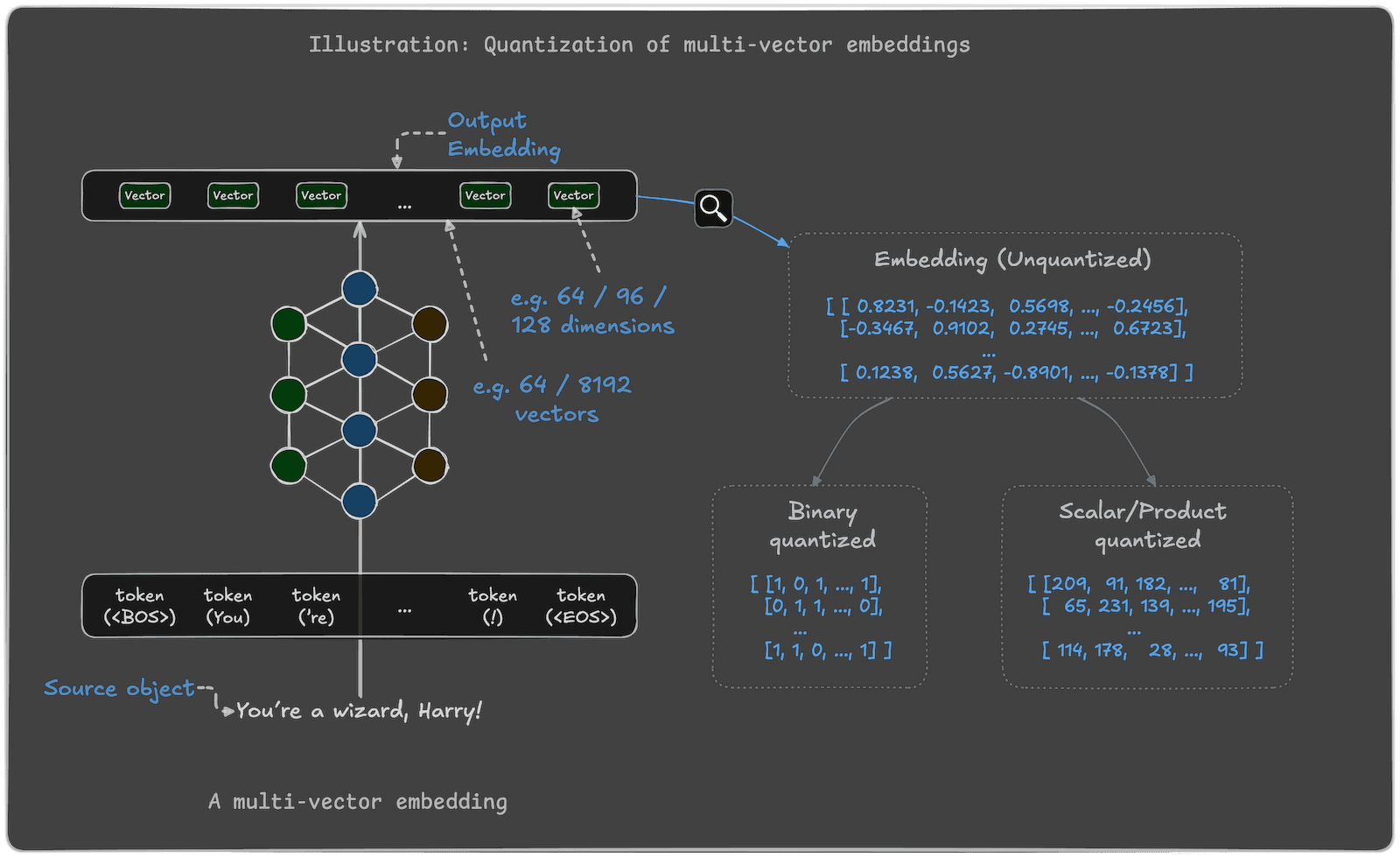
Quantization is a technique that reduces the size of the vectors by approximating them with lower precision representations. Multi-vector embeddings are typically larger than single-vector embeddings. So quantization may be even more important than for single-vector embeddings.
We know this would be a welcome feature for those of you looking to go to production with multi-vector embeddings. Quantization is available for all multi-vector embeddings, regardless of what model it came from.
If you have been waiting for multi-vector embeddings to be generally available, or if you are interested in quantization, now is the time to try it out!
Database user management API
User management is a whole lot more flexible from v1.30. Weaviate now supports management of database users through an API in addition to environment variable-based database users, and OIDC users.
This means that there are broadly three ways to manage database users in Weaviate:
- Through an external identity provider (OIDC)
- Through environment variables (as before; root users must be managed this way)
- Through the database user management API (new)
Administrators can now create and delete database users using the Weaviate client libraries, or the REST API. Even better, changes to the set of API-based database users will take effect without restarting the Weaviate instance.
You can create, delete, and even rotate these database users' API keys without restarting Weaviate. This is a big improvement over the previous method of managing database users, which required restarting Weaviate to apply changes.
Individual users' access can be granted, revoked or made secure again in real-time without the need for downtime. It can be combined with role-based access control (RBAC) to provide a powerful and flexible access control system.
Generative capability improvements
Weaviate's retrieval-augmented generation (RAG) capabilities are now easier to use and more powerful, with runtime options for model providers, and the ability to add images to the input.
From v1.30, you can specify at query time which model provider (e.g. Cohere, Google, OpenAI, etc.) to use for generative capabilities, as well as a specific model and other types. For example:
# Set the provider, model, and other options at query time to override the defaults
gen_provider = GenerativeProvider.cohere(model="command-r-plus")
response = your_collection.generate.near_text(
query="European summer destinations",
limit=10,
generative_provider=gen_provider, # This overrides the default provider / settings
grouped_task="Suggest some summer trip ideas involving some of these destination"
)
print(response)
This means that you can have a default provider & model for your Weaviate collection, and also override at query time for specific requests.
For example, you might want to use a different model for a specific query, or use a different temperature settings for a specific query. This is now possible, giving you more flexibility and control over your generative capabilities.
Additionally, you can now add images to the input of the generative model as context. This can help you to get more out of modern vision language models from providers such as Anthropic, Google, and OpenAI, for example.
xAI model integration
Weaviate's suite of model integrations now includes support for xAI's generative AI models.
To use xAI's generative AI models with Weaviate, take a look at the xAI model integration page for detailed instructions on how to configure Weaviate with xAI models and start using them in your applications.
Other enhancements
Runtime config management
Some system configuration options can now be set and changed at runtime, where they were previously only available at startup.
Weaviate will now periodically look for the presence of a configuration file to read settings for enabling async replication and autoschema, as well as the maximum number of collections that can be created.
This means that you can now change these settings without restarting Weaviate, which can be useful for managing Weaviate instances in production.
For detailed instructions on how to set this up, and what settings are available, refer to the Runtime config management page.
Collection count limits
There is now a default limit on the number of collections that can be created in each Weaviate instance. This has two benefits.
One, it prevents a user from creating too many collections, which can slow down the system. Two, it acts as a trigger to consider whether the architecture of the system is correct, and whether a multi-tenant approach might be more appropriate.
The default limit is set to 1000 collections per Weaviate instance. You can change this limit by setting MAXIMUM_ALLOWED_COLLECTIONS_COUNT in the environment variables.
However, if you finding yourself hitting or even nearing this limit, we advise you to check out this guide on scaling limits with collections to see if you can optimize your Weaviate instance.
This is a good opportunity to consider whether you need to create so many collections, or whether you can use a multi-tenant approach instead.
Tokenizer concurrency limits
Weaviate's non-English tokenizers now have a concurrency limit to prevent them from consuming too many resources. By default, the limit is set to Go's CPU core count (GOMAXPROCS) - but you can adjust this limit to suit your needs.
This can help you to balance the needs between performance and resource consumption.
If you need to change this limit, you can do so by setting the TOKENIZER_CONCURRENCY_COUNT environment variable.
RBAC updates
The engineering team continue to make even more improvements to the role-based access control (RBAC) API to allow further granular control over user permissions. The latest updates include the ability to filter for tenants for Data and Tenant permissions.
See the RBAC documentation for more information.
Summary
Ready to Get Started?
Enjoy the new features and improvements in Weaviate 1.30. The release is available open-source as always on GitHub, and will be available for new Sandboxes on Weaviate Cloud very shortly.
For those of you upgrading a self-hosted version, please check the migration guide for detailed instructions.
It will be available for Serverless clusters on Weaviate Cloud soon as well.
Thanks for reading, see you next time 👋!
Ready to start building?
Check out the Quickstart tutorial, or build amazing apps with a free trial of Weaviate Cloud (WCD).
Don't want to miss another blog post?
Sign up for our bi-weekly newsletter to stay updated!
By submitting, I agree to the Terms of Service and Privacy Policy.
